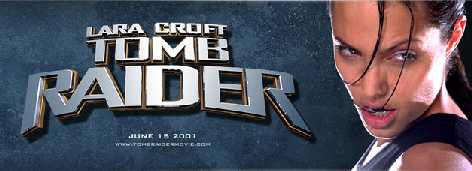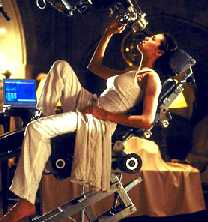
| Bad Astronomy |
|
|
|
BA Blog
|
|
Q & BA
|
|
Bulletin Board
|
| Media |
|
|
|
Bitesize Astronomy
|
|
Bad Astro Store
|
|
Mad Science
|
|
Fun Stuff
|
| Site Info |
|
|
|
Links
|
| RELATED SITES |
| - Universe Today |
| - APOD |
| - The Nine Planets |
| - Mystery Investigators |
| - Slacker Astronomy |
| - Skepticality |
Buy My Stuff

Keep Bad Astronomy close to your heart, and help make me
filthy rich. Hey, it's either this or one of those really
irritating PayPal donation buttons here.
Review: Tomb Raider

Does anyone but me remember when action movies were good? When will we get another flick like Raiders of the Lost Ark or Diehard? These were smart, well-directed, scripted beautifully, and fun. Tomb Raider is none of these. Now, don't get me wrong, I am but a mortal man and so Angelina Jolie was indeed a draw to the movie, but she was really the only one. The scripting was a mess, and the plot stole ideas from so many movies it was difficult to keep track (even Galaxy Quest, for criminy's sake, with the device that lets you go back in time and fix something you messed up. Sure, that's an old old idea, but Tomb Raider did it just like Galaxy Quest did).
I understand the movie was more fantasy than anything else. Even so, the mystical mumbo-jumbo was pretty silly. But more to the point, it involved astronomy, so off we go.
Bad:
Here's the basic plot: every 5000 years, the planets align. The last time
this happened, a meteor fell to the Earth. The metal from the meteorite
was used to make a Mystical Device, which can Stop Time, Give Great Power,
and Do Other Things that require capital letters for emphasis.
Good:
Hmmmph. Planetary alignments leave me a little cold. In the year 2000
there was quite the trouble with
charlatans trying to use a so-called alignment to scare people into spending
money. Given that the movie is a fantasy, this doesn't bug me too
much; after all, I didn't have any real problem with the movie
Mission to Mars
using the Face on Mars as
plot device either. However...
 Bad:
Bad:
... in an early scene we see Lara Croft looking through a telescope
at the alignment. This 'scope, which is in her house, shows her
the planets Uranus, Neptune, and Pluto beginning to align.
Good:
First, a room inside a house is a bad place for a telescope. Scriptwriters
seem to have a hard time with this idea, given that it is used in
Asteroid,
Doomsday Rock,
and a host of other movies. Anyone walking around will shake the image,
for one. The lights on in the room (as you can see in the image here)
would make it impossible to see anything, for another.
Second, and hear me clearly on this, the planets cannot align in this way. A common misconception is that the planets all orbit the Sun in the same plane, so that the solar system would look flat if seen edge-on. However, that's not right. The orbits of the planets all have a tilt relative to the Earth's. For some planets it isn't much, but it's certainly enough that it's extremely rare to get even two planets in the sky so close together that they can be seen at the same time in a telescope. For example, the closest alignment I could find on record involved the planets Mercury through Saturn; in 1952 BC they were all in a circle about 3 degrees apart. That is a circle about six times wider than the full Moon. It would be very impressive to the naked eye, but you wouldn't be able to fit all those planets into your field-of-view through a telescope. Remember, too, that alignment didn't involve Uranus, Neptune, or Pluto either.
It gets worse. Pluto's orbit is tilted by a whopping 17 degrees from the plane of Earth's orbit (technically called the ecliptic), which is huge compared to the size of the planet itself. That means that it is only very rarely near Neptune in the sky. In space, Pluto is never physically near Neptune due to peculiarities in their orbits; you can read all about that on one of my Bitesize pages, or on Bill Arnett's Nine Planets page, or even at a page from Scientific American's website.
On a more fundamental level, when Lara looks through her 'scope she clearly sees the disks of Uranus, Neptune and Pluto. However, even with the best telescopes on Earth, Pluto looks like a little dot. It's too small and too far away to show much of a disk. Even Uranus and Neptune are small disks through a big telescope.
However, there was one neat thing about this: in the movie they say the alignment will last for a week. Mercury, the planet closest to the Sun, moves the quickest, and Pluto the slowest. So for the alignment to last this long, the slowest planets must align first, just as they depict it! Think of it this way: if Mercury and Venus align first, then by the time the more sluggish planets move into the picture, the fast ones will have moved off. So it makes more sense if the slow ones position themselves and then the fast ones slide in. So score one for Good Astronomy!
Bad:
Later, at the moment of the alignment, the Moon slips in front of the Sun
creating a total solar eclipse. As this is happening, we can see all of the
dark disk of the Moon as it eclipses the Sun.
 Good:
Good:
This is a very common way movies depict eclipses, but it isn't right.
Just before a solar eclipse, the Moon is almost aligned with the Sun. That
means the side facing us is in shadow; that is, it's dark. That dark
disk is sitting in a sky that is thousands or perhaps millions of
times brighter. That makes the dark part of the Moon impossible to see!
Even when the Moon is a crescent it's hard to see in the daytime sky,
and you never see the rest of it. Only after sunset, when the
sky darkens, can you glimpse the unlit portion of the Moon. Even then
it would be impossible except that the dark part is sometimes
visible
because it reflects Earthlight back to us. Like the Moon can illuminate
the Earth, the Earth also lights up the Moon a bit, making it possible to
see the dark part. But that's not nearly enough to be able to see it
in the sky when it's that close to the Sun.
I'll add that the lit part of the crescent Moon is very difficult to spot too. There is a running contest to see who can see the "earliest" Moon; that is, who can see the Moon at its thinnest. This happens just hours after its closest approach to the Sun. I have seen it about a day after closest approach and the Moon was the narrowest sliver of silver. It was beautiful, but it was almost impossible to see. It would be pretty near impossible just before solar eclipse.
By the way, clicking on the animated image there opens up the wonderful Mr. Eclipse website, with tons of info about eclipses. Check it out!
Bad:
Also, at the moment of the alignment culmination, we see a shot from space
showing the planets all in a row.
Good:
As I said, this literally cannot happen. The depiction is wrong in
another sense, though. We see the disks of all the planets, as if they
are close together in space as well as in the sky. Actually, if you
were out in space, the planets would just look like stars to your naked eye;
the very word "planet" means "wanderer", because the
ancients thought planets to be wandering stars.
It is sort-of possible to see the planets with disks like this. If you look through a telescope, all the planets get magnified. So if you look through a telescope at a planetary alignment (not that they ever happen like this), you would indeed see the planets all with disks of various sizes, and it would appear that they were close together in space. I don't think this is what the director had in mind when he showed this shot in the movie, though. However, I thought I'd throw that in there to be fair.
So, all in all, I would say give this movie a miss unless you are a fan of Ms. Jolie's. I heard that there are two sequels in the works, of course. Let's hope that, like many other movies, the next movies actually are scripted better!
If you want to find more info about Tomb Raider on the web, try some of these links:
-
The official movie website
-
The official game website
-
An unofficial game website (NOTE: lots of popups)
- A zillion Angelina Jolie links
-
The Self-Made Critic's review of the movie, which, though funny
and on-target, is not as funny as the image at the top of his review.
- Oh, there are a million websites out there for the game and
the movie. Try doing a
Google search
to track them down.
This page last modified
|
|
 |